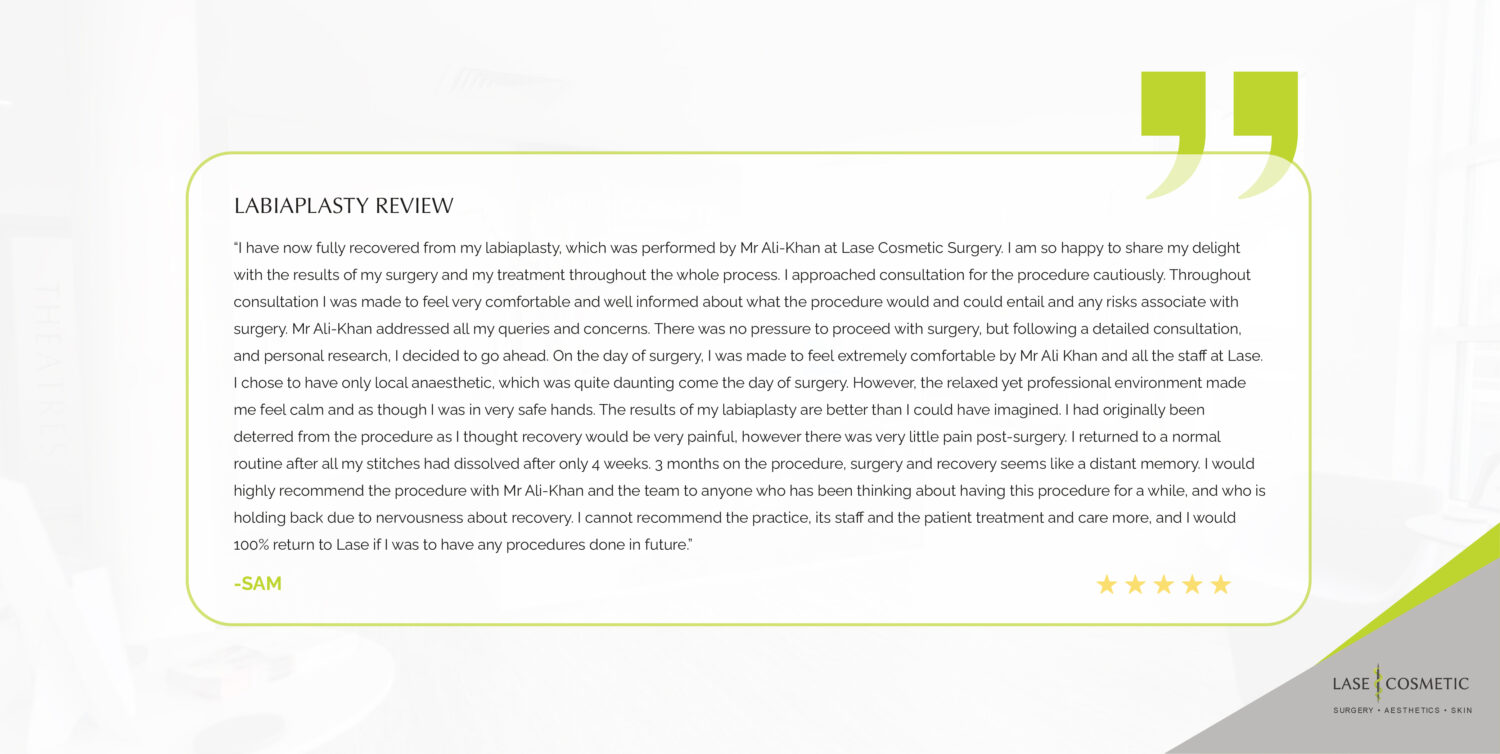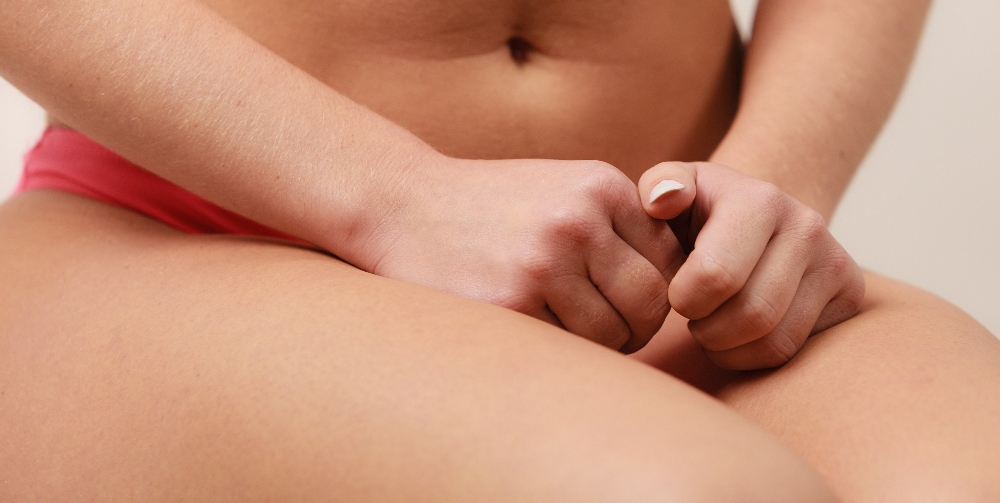If you’re curious about labiaplasty recovery time and what’s involved, keep reading this blog post. Labiaplasty is a personal decision and something many women have considered for some time.
Whether you’re experiencing physical discomfort or you feel self-conscious about your body, labiaplasty can improve your confidence. As a surgical procedure designed to reshape or reduce the labia minora, this helps create a more balanced, comfortable result.
For patients, this brings both physical and emotional benefits as it might be something that’s holding you back in your personal life. However, any sort of surgical treatment is a big decision and you want to make sure you’re in safe hands.
There’s lots of clinics online offering the same thing, but knowing you can trust the surgeon behind the procedure is key. At LASE Cosmetic, we insist on a one-to-one consultation before any treatment takes place to help us determine your goals and the best course of action, but also so you can put a face to the name.
Feeling confident in the treatment and the surgeon behind it is a priority so we make patients feel as comfortable as possible. That said, let’s explore exactly what labiaplasty is and what’s involved.
What Is Labiaplasty?
Labiaplasty is a surgical treatment aimed to reshape or reduce the labia minora which is the inner folds of the skin around the vaginal opening. However it’s important to highlight that every woman is different so there’s no exact definition of what a normal labia “should” look like – it’s personal preference.
That said, some women may find that their labia feel enlarged, uneven, or cause physical discomfort such as when they’re exercising or wearing certain clothes.
The labia are the folds of skin that surround the vaginal opening. The outer folds, known as the labia majora (meaning “large lips”), are the thicker folds that help protect the external genital area. The inner folds, called the labia minora (“small lips”), sit inside the outer folds and protect the openings of the urethra (where urine leaves the body) and the vagina.
A labiaplasty is a procedure that changes the size or shape of the labia. Depending on your needs, your surgeon may:
- Reconstruct the labia using tissue from another area
- Remove tissue to make the labia smaller
- Add filler or fat to increase volume
Why Do People Undergo Labiaplasty?
The procedure itself is relatively simple and can be carried out under local anaesthetic or general anaesthetic. The surgeon carefully reshapes the labia to achieve a more balanced size and appearance, with the aim of creating natural-looking results.
It’s often viewed as a cosmetic procedure and a way to improve your bodily appearance, however labiaplasty can also have functional benefits. For instance, women who experience irritation when exercising or pain during intimacy may find relief after surgery.
Another reason for considering the procedure is improved hygiene and health, as excess tissue can make cleansing more difficult and may trap bacteria that increase the risk of urinary tract infections (UTIs).
At LASE Cosmetic, we take a personalised approach to every patient. That means listening to your concerns and advising whether labiaplasty is the right choice for you. This way, you get treatment that’s not only safe but also suited to your individual needs.
What Causes Uneven Labia?
For many women, uneven labia is simply down to genetics while for others, changes can develop over time due to hormone changes or life events.
Some reasons for uneven labia are listed here:
- Genetics – The most common cause is simply genetics and the way the body develops; the same way as breasts change in size from one person to another. It’s normal for one side of the labia to be slightly different in size or shape than the other.
- Hormones – Changes in hormones during puberty, pregnancy, or menopause can affect tissue growth and may make one side of the labia more prominent.
- Pregnancy and childbirth – The strain of giving birth, along with pregnancy-related hormonal changes, can stretch or change the shape of the labia.
- Ageing – As the skin loses elasticity with age, differences between the two sides of the labia may become more noticeable.
In most cases, uneven labia are completely normal and don’t indicate any health concern. However, if it affects your confidence, you might want to explore treatment options.

Labiaplasty Surgery
To give you a better insight into what’s involved in labiaplasty, we’re detailing what happens before, during, and after surgery. This helps you feel more prepared about what to expect, and the recovery time.
As a general rule, before having labiaplasty you should be prepared to book some time off work and have a break from any exercise you usually do.
Before
Before surgery takes place, you’ll have a one-to-one consultation with your surgeon where you’ll discuss your goals for the treatment and expected outcome.
Your surgeon should also tell you about the plan for the treatment including how your labia will be reshaped, reduced, or reconstructed depending on what you want to achieve.
You’ll also be given some instructions on:
- When to stop eating or drinking
- Which medications to stop or adjust
- What would be best to wear on the day of surgery
During
On the day of your procedure, the area will be cleansed in preparation and any hair will be removed if necessary. You’ll also receive anesthesia, either local with sedation or general anesthesia depending on what’s been agreed.
There are different surgical techniques depending on your goals including:
Reduction
- Trim procedure: This where tissue is removed from the outer edge for a smoother, more even look.
- Wedge procedure: A wedge-shaped piece from the inner area is removed, preserving the natural edge while also reducing size.
Enlargement
- This transfers fat from a different part of your body for example your abdomen or things to add volume.
- Injectable fillers like hyaluronic acid, can also be used to increase fullness without surgery.
Reconstruction
- Reconstruction might involve using tissue from another area of the body (for example, in gender-affirming surgery).
All incisions are closed with dissolvable stitches, and the area is dressed with a protective surgical covering.
After
Generally, labiaplasty is done on an outpatient basis meaning you can go home the same day.
That said, you’ll have to take it easy as you will be a little sore, so the following aftercare instructions are usually given regarding:
- How to keep the area clean
- How to manage any pain
- Any activities to avoid
- Information on what’s normal during recovery and when to contact your surgeon
You will also have follow-up appointments to check healing and remove any dressings if needed.
Labiaplasty Recovery Time
Labiaplasty recovery time usually spans several weeks however it depends on the individual.
Knowing what to expect during each stage of recovery can help you plan ahead and ensure the best results.
- First week – It’s normal to experience swelling, bruising, and mild discomfort around the labia. Your surgeon may recommend ice packs and/ or wearing loose-fitting clothing. You may also notice some minor bleeding or discharge, which is normal in the first few days.
- Weeks 2 to 4 – Swelling and bruising should start to subside and you may notice the labia becoming less tender. Many patients can return to work, provided they avoid strenuous exercise or activities.
- After one month – Most patients find that discomfort has significantly eased. Sexual activity can often be resumed, though you should still follow your surgeon’s advice. Final results such as the shape, size, and symmetry of the labia can take several months to fully settle.
Labiaplasty Reviews
Below is a labiaplsty review from a previous client at LASE, describing their experience of the treatment and how the whole process was handled.

Labiaplasty Recovery Time: Your Questions Answered
Labiaplasty recovery time varies depending on the individual but typically patients can resume some activities in the first couple of weeks, with a full recovery often taking up to 6 weeks.
That said, this procedure serves both functional and emotional benefits from increasing your confidence to making every day activities more comfortable.
It’s important to reiterate that there is no “normal” labia as every woman is different. That said, if you have concerns, it’s important to speak with a qualified surgeon who can provide advice on the best course of treatment. At LASE, all procedures are carried out by fully qualified surgeons, and as a clinic, we hold full CQC surgical certification, ensuring the highest standards of safety, care, and professionalism.
Book your consultation with one of our friendly, qualified surgeons here.

Need Help Deciding Which Treatment Is Right For You?
Book your consultation with our experts here.


Recent Comments